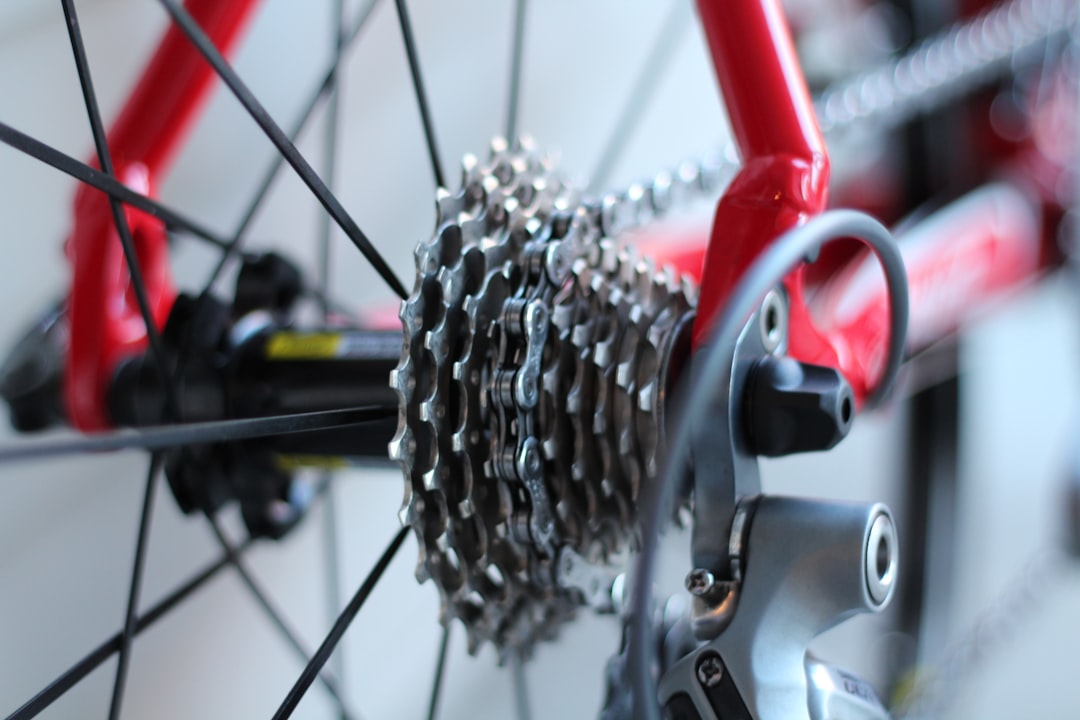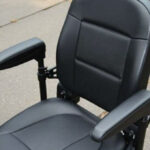Fine-Tuning Your Bike: Adjusting the Rear Derailleur
If you’re looking for a quick answer on how to adjusting a rear derailleur, here’s a simple rundown:
- Make sure your derailleur hanger is straight.
- Check high and low limit screws.
- Fine-tune the cable tension with the barrel adjuster.
- Verify chain and components are in good condition.
Your bike’s performance relies on a well-adjusted rear derailleur.
A rear derailleur is akin to a World Tour Team’s strongest domestique: one of the hardest working yet rarely appreciated parts of your bike. It shifts gears smoothly and keeps your chain perfectly tensioned. But when it stops working right, you’ll end up with an irritating, noisy, and imprecise ride.
The rear derailleur moves the chain across different cogs on your rear cassette, maintaining proper tension whether you’re climbing steep hills or speeding down flat roads. It does this thanks to a clever mechanism of pulleys, cables, and limit stops.
If you can take the time to understand and adjust your rear derailleur properly, you can ensure a smooth, efficient ride and get the most out of your eBike. Let’s dive into how this crucial component works and how to keep it in top condition.

Terms related to adjusting a rear derailleur:
– aventon bike review
– tractive dog tracker
Tools and Preliminary Checks
Before you begin adjusting your rear derailleur, gather the essential tools and perform some preliminary checks. This will ensure you have everything you need and that your bike is ready for adjustments.
Essential Tools
- Repair Stand: Lifts your bike, making it easier to work on and allowing you to pedal freely.
- Screwdriver: A Phillips #2 or straight blade screwdriver is needed for adjusting limit screws.
- Hex Wrenches: These are used for various bolts on the derailleur and bike frame.
- Fourth Hand Tool (BT-2): Helps pull the cable tight when making adjustments.
- Cable Cutter (CN-10): For trimming the cable cleanly.
- Light Lubricant (CL-1.2): Keeps the derailleur and chain moving smoothly.
- Rags: Useful for cleaning grime off the chain and derailleur.
Preliminary Checks
Visual Inspection
Derailleur Hanger: Begin with a visual check of the derailleur hanger. If it’s bent, your adjustments won’t be accurate. A bent hanger can cause misalignment, making it difficult to shift gears smoothly. If you suspect the hanger is bent, refer to a hanger alignment guide for instructions on fixing it.
Chain Wear
A worn-out chain can cause poor shifting and even damage your cassette. Use a chain checker tool to measure wear. Look for a 0.5% or 0.75% wear indication. If your chain shows excessive wear, replace it before proceeding with derailleur adjustments.
Pro Tip: Regularly check your chain wear to avoid long-term damage to your drivetrain.
Damaged Housing or Frayed Cable
Inspect the cable housing from the shifter to the derailleur. Look for any extreme bends, pinches, or frayed cables. Damaged housing or cables can restrict movement and cause shifting issues. Replace any damaged components before making adjustments.
Bent Derailleur Hanger
A bent derailleur hanger is a common issue that can cause shifting problems. If your bike has fallen or been stored improperly, the hanger may be misaligned. Check it visually and straighten it if necessary. A properly aligned hanger ensures accurate shifting.
Note: Derailleur hangers are made of soft metal and can bend easily. Always handle with care.
Lubrication
Before making adjustments, apply a light lubricant to the derailleur and chain. This reduces friction and ensures smooth movement. Wipe off any excess with a rag to prevent attracting dirt.
Conclusion
With these tools and preliminary checks, you’re ready to start adjusting your rear derailleur. Ensuring everything is in good condition before making adjustments will save you time and headaches down the road.

Next, we’ll dive into understanding the components of the rear derailleur.
Understanding Rear Derailleur Components
Before you start adjusting a rear derailleur, it’s crucial to understand its components. Each part plays a role in smooth and precise shifting. Let’s break down the main components:
B-Knuckle
The b-knuckle is the upper part of the derailleur that connects to the derailleur hanger on your bike frame. It serves as the pivot point for the derailleur’s movement.
B-Tension Adjuster
The b-tension adjuster fine-tunes the height of the guide pulley relative to the cogs. On Shimano and SRAM derailleurs, this is a screw near the b-knuckle. On Campagnolo derailleurs, the adjustment screw is near the p-knuckle. Correct b-tension ensures smooth shifting across all gears.
Barrel Adjuster
The barrel adjuster is used to fine-tune the cable tension. It’s typically located where the cable enters the derailleur. Adjusting the barrel adjuster helps achieve precise shifts by tightening or loosening the cable incrementally.
Guide Pulley
The guide pulley (or jockey pulley) is the upper pulley on the derailleur. It guides the chain from cog to cog during shifts. Proper alignment of the guide pulley is essential for accurate shifting.
Idler Pulley
The idler pulley is the lower pulley that helps maintain chain tension regardless of gear choice. It works in tandem with the guide pulley to ensure smooth chain movement.
Mounting Bolt
The mounting bolt attaches the derailleur to the derailleur hanger on the bike frame. It must be securely fastened to avoid derailleur movement during riding.
Parallelogram Linkage
The parallelogram linkage allows the derailleur to move left and right, and up and down the cassette while remaining parallel to the cogs. This ensures the chain moves smoothly during shifts.
High and Low Limit Stops
The high and low limit stops are screws that prevent the derailleur from moving too far inward or outward. The high limit stop (often marked “H”) prevents the chain from dropping off the smallest cog, while the low limit stop (marked “L”) prevents it from shifting into the spokes.
P-Knuckle
The p-knuckle holds the guide pulley and includes a spring that maintains tension on the derailleur cage. It ensures the chain remains taut during shifts.
Cable Bolt
The cable bolt secures the shift cable to the derailleur. When the shift lever pulls the cable, it moves the derailleur up the cassette to a lower gear. Conversely, releasing the cable moves it to a higher gear.
Cage
The cage houses the guide and idler pulleys. It keeps the chain in line between the pulleys, ensuring consistent tension and smooth shifting.
Understanding these components will make adjusting your rear derailleur much easier. Next, we’ll dive into the specific adjustments needed to fine-tune your derailleur for optimal performance.
Adjusting a Rear Derailleur
Limit Screws
The limit screws play a crucial role in preventing your chain from slipping off the cogs and causing damage. There are two limit screws: the H-limit screw and the L-limit screw.
H-Limit Screw
The H-limit screw controls how far the derailleur can move toward the smallest cog. If this screw is set incorrectly, the chain might drop off the smallest cog or fail to shift properly.
To adjust the H-limit screw:
- Shift to the smallest cog: Make sure the chain is on the smallest rear cog.
- Check derailleur movement: Tighten the H-limit screw until the derailleur stops moving outward.
- Fine-tune: Back out the screw until the derailleur sits directly below the smallest cog. Listen for excessive noise while pedaling. If you hear rubbing, back out the screw in small increments until the noise stops.
L-Limit Screw
The L-limit screw manages the derailleur’s inward movement toward the largest cog. Incorrect settings can cause the chain to drop into the spokes, which can be catastrophic.
To adjust the L-limit screw:
- Shift to the largest cog: Move the chain to the largest rear cog.
- Check for noise: If the chain makes excessive noise or shifts slowly, the L-limit screw might be too tight.
- Fine-tune: Tighten the L-limit screw until the chain rubs, then back out the screw until the noise ceases.
Indexing Adjustment
Indexing ensures that each shift click aligns perfectly with each cog. Precise indexing leads to smooth, reliable shifts.
Guide Pulley Alignment
- Start on the smallest cog: Shift to the smallest rear cog.
- Shift one click: Pedal normally and shift the lever one click.
- Adjust cable tension: If the chain doesn’t move to the next cog, turn the barrel adjuster counter-clockwise to tighten the cable. If the chain skips a cog, turn it clockwise to loosen the cable.
Fine-Tuning
- Incremental shifts: Shift through each gear, listening for noise and checking for smooth transitions.
- Acceptable range: The barrel adjuster has a range of acceptable positions. Find the setting that minimizes noise and maximizes smooth shifts.
B-Screw Adjustment
The B-screw (or body-angle screw) adjusts the spacing between the guide pulley and the cogs. Proper spacing ensures smooth shifting across the entire cassette.
Setting the B-Screw
- Shift to the largest cog: Move the chain to the largest rear cog.
- Check spacing: The gap between the guide pulley and the cog should be 5-6 millimeters. Use a hex wrench to measure this distance.
- Adjust: Tighten the B-screw to increase the gap, or loosen it to decrease the gap.

The goal is to have the guide pulley close enough to the cogs for crisp shifts but not so close that it causes rubbing.
By following these steps, you’ll ensure your rear derailleur is properly adjusted, providing smooth and reliable shifting. Next, we’ll walk you through a step-by-step guide to fine-tuning each component for optimal performance.
Step-by-Step Guide to Adjusting a Rear Derailleur
H-Limit Screw Adjustment
To start adjusting your rear derailleur, let’s focus on the H-limit screw. This screw controls how far the derailleur can move toward the smallest cog.
- Visual Check: Before you start, ensure the derailleur hanger is not bent. A bent hanger will make proper adjustment impossible.
- Shift to the Smallest Cog: Make sure the chain is on the smallest rear cog.
- Check Derailleur Movement: Tighten the H-limit screw until the derailleur stops moving outward.
- Fine-Tune: Back out the screw until the derailleur sits directly below the smallest cog. Listen for excessive noise while pedaling. If you hear rubbing, back out the screw in small increments until the noise stops.
L-Limit Screw Adjustment
Next, let’s adjust the L-limit screw. This screw manages the derailleur’s inward movement toward the largest cog.
- Shift to the Largest Cog: Move the chain to the largest rear cog.
- Check for Noise: If the chain makes excessive noise or shifts slowly, the L-limit screw might be too tight.
- Fine-Tune: Tighten the L-limit screw until the chain rubs, then back out the screw until the noise ceases. This prevents the chain from dropping into the spokes.
Indexing Adjustment
Indexing ensures each shift click aligns perfectly with each cog, leading to smooth, reliable shifts.
Guide Pulley Alignment
- Start on the Smallest Cog: Shift to the smallest rear cog.
- Shift One Click: Pedal normally and shift the lever one click.
- Adjust Cable Tension: If the chain doesn’t move to the next cog, turn the barrel adjuster counter-clockwise to tighten the cable. If the chain skips a cog, turn it clockwise to loosen the cable.
Fine-Tuning
- Incremental Shifts: Shift through each gear, listening for noise and checking for smooth transitions.
- Acceptable Range: The barrel adjuster has a range of acceptable positions. Find the setting that minimizes noise and maximizes smooth shifts.
B-Screw Adjustment
The B-screw (or body-angle screw) adjusts the spacing between the guide pulley and the cogs. Proper spacing ensures smooth shifting across the entire cassette.
Setting the B-Screw
- Shift to the Largest Cog: Move the chain to the largest rear cog.
- Check Spacing: The gap between the guide pulley and the cog should be 5-6 millimeters. Use a hex wrench to measure this distance.
- Adjust: Tighten the B-screw to increase the gap, or loosen it to decrease the gap.
The goal is to have the guide pulley close enough to the cogs for crisp shifts but not so close that it causes rubbing.
By following these steps, you’ll ensure your rear derailleur is properly adjusted, providing smooth and reliable shifting. Next, we’ll walk you through a step-by-step guide to fine-tuning each component for optimal performance.
Common Issues and Troubleshooting
When adjusting a rear derailleur, several common issues can arise. Addressing these problems promptly ensures smooth and reliable shifting.
Chain Wear
Over time, your bike chain will wear out, a process often called “chain stretch.” This isn’t actual stretching but rather wear on the rollers and pins, making the chain longer. A worn chain can cause poor shifting and even damage your cassette and chainrings.
- Check Chain Wear: Use a chain checker tool. If the tool slides into the chain at 0.5% wear, it’s time to replace the chain. For a more manual check, measure 12 inches from pin center to pin center. If it exceeds 12-¹⁄₁₆ inches, replace the chain.
Stiff Chain Link
A stiff chain link can cause skipping and poor shifting. This usually happens due to corrosion or damage.
- Identify Stiff Links: Back-pedal and watch how the chain moves through the pulleys. If a link skips, it’s likely stiff.
- Fix Stiff Links: Apply lube to the stiff link and gently flex it side to side until it moves smoothly.
Excessive Wear
Excessive wear on the chain, cassette, or chainrings can lead to shifting problems and chain skips.
- Inspect for Wear: Look for worn teeth on the cassette and chainrings. Replace any excessively worn parts to restore smooth shifting.
Damaged Housing or Frayed Cable
Damaged housing or frayed cables can restrict derailleur movement, leading to shifting issues.
- Inspect Housing: Check for kinks, bends, or visible damage. Replace the housing if any issues are found.
- Check Cables: Look for fraying, especially at bends and attachment points. Replace frayed cables immediately.
Bent Derailleur Hanger
A bent derailleur hanger is a common cause of shifting problems. It can happen if the bike falls or is mishandled.
- Visual Check: Look at the derailleur hanger from behind. If it’s not aligned with the cogs, it’s likely bent.
- Fix Alignment: Use a hanger alignment tool to straighten it. This tool ensures the hanger is perfectly aligned for smooth shifting.
By addressing these common issues, you can troubleshoot and resolve many shifting problems. This will ensure your rear derailleur functions optimally, providing a smooth and safe ride.
Frequently Asked Questions about Adjusting a Rear Derailleur
How do you adjust a Shimano rear derailleur?
Adjusting a Shimano rear derailleur involves a few key steps. Start by ensuring the derailleur hanger is straight, as a bent hanger can cause shifting issues.
- Barrel Adjuster: The barrel adjuster fine-tunes the cable tension. Turn it counter-clockwise to increase tension and clockwise to decrease it.
- Cable Position: Shift to the smallest cog and ensure the cable is snug but not overly tight. Loosen the cable anchor bolt, pull the cable through, and retighten the bolt.
- Anchor: The cable anchor bolt secures the cable in place. Make sure it’s tight enough to hold the cable but not so tight that it strips the bolt.
What does the B screw do on a rear derailleur?
The B screw, also known as the B-tension screw, adjusts the spacing between the guide pulley and the cogs. This spacing is crucial for smooth shifting, especially when moving to larger cogs.
- Spacing: Proper spacing ensures the guide pulley clears the cogs without rubbing.
- Guide Pulley: Adjust the B screw until the guide pulley is close but not touching the largest cog.
- Cogs: Check the alignment by shifting to the largest cog. The guide pulley should be close enough to provide accurate shifts without causing chain noise.
What are the H and L screws on a rear derailleur?
The H and L screws are limit screws that set the outermost and innermost limits of the derailleur’s movement.
- H-Limit Screw: The H (High) screw controls the derailleur’s position on the smallest cog. Tightening this screw moves the derailleur inward, while loosening it allows more outward movement.
- L-Limit Screw: The L (Low) screw controls the derailleur’s position on the largest cog. Tightening this screw moves the derailleur outward, while loosening it allows more inward movement.
- Limit Screws: Properly setting these screws prevents the chain from dropping off the cogs or shifting into the spokes.
By understanding and properly adjusting these components, you can ensure smooth and reliable shifting on your bike.
Next, let’s dive into the step-by-step guide for adjusting your rear derailleur.
Conclusion
Adjusting a rear derailleur may seem daunting, but with the right steps, it’s a task that any cyclist can master. Proper adjustment ensures smooth and reliable shifting, which is crucial for a safe and enjoyable ride. Misaligned gears can disrupt your momentum, especially during climbs or quick getaways in traffic, and can even lead to more serious mechanical issues.
Importance of Proper Adjustment
A well-adjusted rear derailleur means:
- Smooth Shifting: No more annoying clicks or jumps between gears.
- Safety: Prevents the chain from slipping, which can cause accidents.
- Efficiency: Keeps your ride smooth and your energy focused on forward motion.
Doot Scoot and Eco-Friendly Urban Mobility
At Doot Scoot, we’re passionate about promoting eco-friendly urban mobility. eBikes are a sustainable solution for city transport, reducing your carbon footprint while providing a fun and efficient way to get around. By ensuring your bike is in top shape, you’re not only enhancing your ride but also contributing to a greener planet.
Customer Support and Community Building
We believe in building a supportive community of eBike enthusiasts. Whether you’re a seasoned rider or new to eBikes, we’re here to help. Our comprehensive guides, like this one on adjusting a rear derailleur, are designed to empower you with the knowledge you need.
- Customer Support: Have questions or need help? Our team is ready to assist via email or live chat.
- Community Building: Join our online community to share tips, experiences, and reviews. Let’s ride together towards a more sustainable future.
By maintaining your bike and staying engaged with the Doot Scoot community, you’re not just a rider—you’re part of a movement towards sustainable urban living.
Feel free to explore more guides and tips on our website to keep your ride smooth and eco-friendly. Happy riding!










